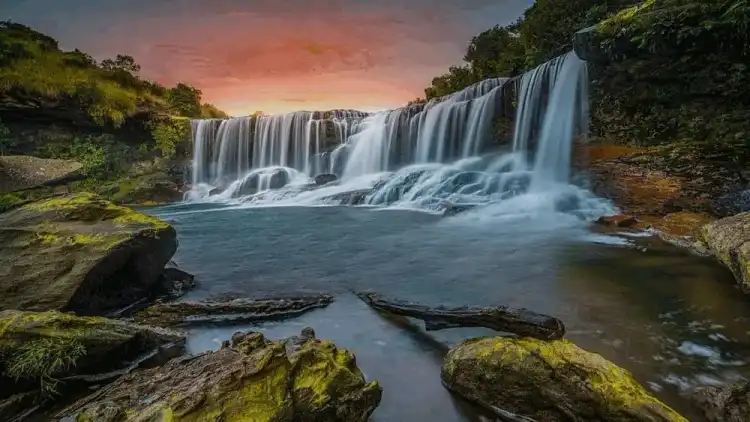Eastern West Khasi Hills District: A Comprehensive Overview
Introduction
Eastern West Khasi Hills District, nestled in the northeastern state of Meghalaya, India, is a region rich in natural beauty, cultural diversity, and historical significance. This article delves deep into the intricate details of this enchanting district, covering its demography, culture, geography, topography, cuisines, history, notable poets and authors, and administrative structure.
Demography
Eastern West Khasi Hills District is predominantly inhabited by the Khasi people, an indigenous ethnic group known for their matrilineal society. According to the latest census data, the district has a population of approximately 150,000 people. The population density is relatively low, offering a serene and less congested living environment. The district is also home to a small number of Garo and other tribal communities, contributing to its cultural mosaic.
Population Composition
- Khasi: 85%
- Garo: 10%
- Other Tribes: 5%
Culture
The culture of Eastern West Khasi Hills is deeply rooted in the traditions and customs of the Khasi people. Festivals, music, dance, and oral literature play a crucial role in the cultural fabric of the district. The Khasi festivals such as Ka Shad Suk Mynsiem and Ka Pom-Blang Nongkrem are celebrated with great fervor, showcasing traditional dances and rituals.
Traditional Attire
Khasi men traditionally wear a Jymphong, a sleeveless coat, while women adorn themselves in a Jainsem, a wraparound dress. Silver jewelry and intricate accessories complement their attire, especially during festivals and ceremonies.
Music and Dance
Folk music and dance are integral to Khasi culture. Instruments like the Duitara (a four-stringed instrument) and Ksing (a traditional drum) accompany the rhythmic dance forms such as Nongkrem and Shad Suk Mynsiem.
Geography and Topography
Eastern West Khasi Hills District is characterized by its rolling hills, lush forests, and picturesque landscapes. The district spans an area of approximately 1,500 square kilometers, with altitudes ranging from 800 to 1,600 meters above sea level.
Major Geographical Features
- Nongstoin: The district headquarters, known for its scenic beauty and pleasant climate.
- Langshiang Falls: One of the highest waterfalls in Meghalaya, offering breathtaking views.
- Kynshi River: A major river that traverses the district, providing water resources and scenic vistas.
Cuisines
The culinary traditions of Eastern West Khasi Hills reflect the simplicity and richness of the local lifestyle. The cuisine is primarily based on locally sourced ingredients, including rice, vegetables, fish, and meat.
Signature Dishes
- Jadoh: A traditional rice and meat dish, often served with spicy chutneys.
- Dohneiiong: Pork cooked with black sesame seeds, a flavorful and aromatic preparation.
- Tungrymbai: Fermented soybean paste, commonly used as a condiment or side dish.
Traditional Beverages
- Kyat: A local rice beer, mildly alcoholic and often consumed during festivities.
- Putharo: A type of rice cake, usually paired with tea or as a snack.
History
The history of Eastern West Khasi Hills is rich with tales of indigenous kingdoms, colonial encounters, and cultural evolution. The Khasi Hills were historically governed by local chieftains known as Syiem. The British colonial period saw significant changes in the administration and infrastructure of the region.
Pre-Colonial Era
- Syiemships: The traditional political structure, with each village governed by a Syiem (chief).
- Trade: The Khasis engaged in trade with neighboring regions, exchanging goods like betel nut, lime, and handicrafts.
Colonial Period
- British Annexation: The British established control over the Khasi Hills in the early 19th century, introducing new administrative systems and infrastructure developments.
- Resistance Movements: Notable resistance against British rule, including the U Tirot Sing revolt in 1829-1833.
Notable Poets and Authors
Eastern West Khasi Hills has produced several renowned poets and authors who have contributed to Khasi literature and culture. Their works often reflect the natural beauty, traditions, and social issues of the region.
U Soso Tham
- Major Works: "Ki Sngi Barim U Hynniewtrep" (The Olden Days of the Hynniewtrep)
- Themes: Nature, folklore, and Khasi identity
H. Elias
- Major Works: "Ka Thain Khasi" (The Khasi Land)
- Themes: Social reform, cultural pride, and historical narratives
Administration
The administrative structure of Eastern West Khasi Hills District is designed to ensure effective governance and development. The district is divided into several blocks, each overseen by a Block Development Officer (BDO). The district administration is headed by a Deputy Commissioner (DC), who coordinates various government departments and development programs.
Administrative Divisions
- Nongstoin Block: The central administrative unit, encompassing the district headquarters.
- Mawthadraishan Block: Known for its agricultural activities and scenic landscapes.
- Mairang Block: A hub for local trade and cultural activities.
Development Initiatives
- Infrastructure Development: Ongoing projects to improve road connectivity, healthcare facilities, and educational institutions.
- Agricultural Programs: Initiatives to promote sustainable farming practices and support local farmers.
- Tourism Promotion: Efforts to enhance tourism infrastructure and promote the district as a destination for eco-tourism and cultural tourism.
Conclusion
Eastern West Khasi Hills District is a region that encapsulates the essence of Meghalaya's natural beauty, cultural richness, and historical depth. From its diverse population and vibrant cultural practices to its stunning landscapes and flavorful cuisine, the district offers a unique and enriching experience. As the district continues to develop and modernize, it remains deeply rooted in its traditions, ensuring a harmonious blend of the old and the new.
This comprehensive overview of Eastern West Khasi Hills District highlights its key attributes, providing a detailed insight into what makes this region truly special. Whether you are a traveler, a researcher, or a cultural enthusiast, Eastern West Khasi Hills has much to offer, waiting to be discovered and cherished.
